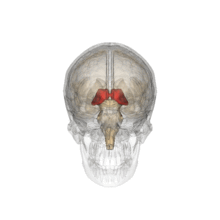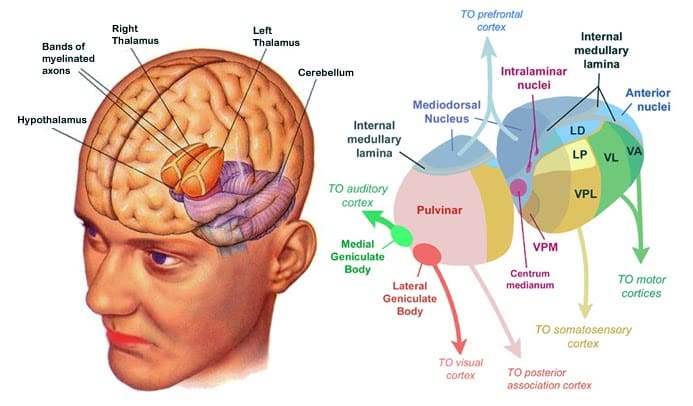The human brain is a very complex and elaborate organ. There are presently countless ongoing studies that are attempting to map out this intricate system. The task is quite complicated due to the numerous components that are a part of the brains composition. One aspect of the brain that is of much interest is the thalamus. The thalamus is a structure located at top of the brain stem in the central core of the brain (Santrock & Mitterer, 2004). Scientists are confident that the thalamus’ main function is to sort received information and send it to the appropriate areas within the brain for further interpretation and absorption. However, a number of studies have shown that distributing the obtained information is not the thalamus’ exclusive purpose. In fact it has been hypothesized that the thalamus is involved in numerous tasks such as perceiving pain as well as influencing the onset and treatment of diseases and disorders, for instance epilepsy.
Pain is a universal sensation; however it occurs in an infinite variety of intensities. Many individuals worldwide are unfamiliar with the process in which the sensation of ‘pain’ is perceived. Santrock and Mitterer (2004) define pain as the sensation that warns the individual of damage  occurring to our bodies (Santrock & Mitterer, 2004). These pain messages are transmitted in one of two manners. The first is what Santrock and Mitterer (2004) term the ‘slow pathway’. In this pathway, pain information travels through the
occurring to our bodies (Santrock & Mitterer, 2004). These pain messages are transmitted in one of two manners. The first is what Santrock and Mitterer (2004) term the ‘slow pathway’. In this pathway, pain information travels through the
limbic system and eventually arrives to the cerebral cortex. At this point one is able to sense ‘pain’. The second method is named the ‘fast pathway’. In this method fibres connect directly to the thalamus and are then sent directly to the cerebral cortex. The fast pathway is the fastest and most efficient system in the forewarning process (Beatty, 2001). In Holden’s (2003) study he scanned the brains of a randomly selected sample while heating a spot on their legs. The vast majority of the participants indicated that the temperature caused some form of discomfort or pain. When the brain scans were examined it was noted that all members demonstrated similarities. Each brain scan consistently displayed an activation of the thalamus (Holden, 2003). A similar study performed by Davis, Pope and Mikulis (2002) confirmed that pain sensations such as the prickle sensation, as noted in their study and other stimuli causing pain such as temperature, stimulate the thalamus (Davis, Pope & Mikulis, 2002). Scientists and psychologists alike are confident in concluding that the thalamus has a significant role in the process of perceiving the sensation of pain.
It has also been noted that the thalamus is involved in the initiation of an array of disorders. One disease in particular is epilepsy. This syndrome involves patients who are subject to frequent seizures. Numerous investigations have indicated that the thalamus has a significant involvement in the maintenance and the severity of the seizures. In Bertram, Mangan, Zhang, Scott and Williamson’s (2001) study they used rat models and simulated a seizure. In observing the brain activity, the most consistently noted region of involvement was the thalamus. They also acknowledged that the manipulation of the thalamus influences the onset of seizures but it can also be used to decrease and control
the amount of seizures. Hodaie, Wennberg, Dostrovsky and Lozano’s (2002) research furthered Bertram, Mangan, Zhang, Scott and Williamson’s (2001) hypothesis. Through the use of deep-brain stimulation of the anterior thalamus in epileptic patients, they noted a statistically significant decrease in the patients’ seizure frequency. In their investigation they recognized that the nucleus of the anterior  thalamus increased in metabolic activity during a seizure. In using high-frequency deep-brain stimulation of the anterior thalamus the increase of metabolic activity can be decreased. In calming this activity the frequency of seizures is significantly reduced (Hodaie, Wennberg, Dostrovsky and Lozano, 2002). Due to their study as well as many other similar investigations deep-brain stimulation of the anterior thalamus has become a potential therapy for the control of epilepsy.
thalamus increased in metabolic activity during a seizure. In using high-frequency deep-brain stimulation of the anterior thalamus the increase of metabolic activity can be decreased. In calming this activity the frequency of seizures is significantly reduced (Hodaie, Wennberg, Dostrovsky and Lozano, 2002). Due to their study as well as many other similar investigations deep-brain stimulation of the anterior thalamus has become a potential therapy for the control of epilepsy.
However, some researchers have realized that there is no certainty that the deep-brain stimulation of the thalamus is the definite cause of the decrease in seizures. As it is uncertain whether it is the lesions of the thalamus that are created while inserting the electrodes that causes the decreases the rate of seizures or whether it is in fact the deep-brain stimulation. As researchers continue to investigate this question they remain confident that in one form or another it is the manipulation of the thalamus that has the considerable impact on the onset and treatment of seizures (Malshima, Ozaki, Okita, Yamago, Kakishita, Moriwaki & Roger, 2001).
In summary the exact purpose of the thalamus is an unsolved mystery however researchers are continually linking the thalamus to many new roles. Currently the thalamus plays an important part in many things such as perceiving things such as pain to even the onset and treatment of disorders such as epilepsy. As studies continue to take place additional involvements of the thalamus will be determined.
References
Bertran, H., Mangan, P., Zhang, D., Scott, C., Williamson, J. (2001). The midline thalamus: alterations and a potential role in the limbic epilepsy. Epilepsia, 42(8), 967. Retrieved February 22nd, 2004 from http://www.epnet.com
Beatty, J. (2001). Principles of neurosciences. Thousand Oaks, California: Sage.
Davis, K., Pope, G., Crawley, A. & Mikulis, D. (2002). Neural correlates of prickle sensation: a percept-related fMRI study. Nature neuroscience, 5(11), 1121-1123. Retrieved February 22nd, 2004 from http://www.epnet.com
Hodie, M., Wennberg, R., Dostovsky, J., & Lozano, A. (2002). Chronic anterior thalamus stimulation for intractable epilepsy. Epilepsia, 43(6), 603-608. Retrieved February 22nd, 2004 from http://www.epnet.com
Holden, C. (2003). What does ‘ouch!’ mean? Science now, 3(4), 2. Retrieved February 22nd, 2004 from http://www.epnet.com
Malshima, S., Ozaki, F., Okita, R., Yamago, H., Kakishita, K., Moriwaki, H., Roger, P. (2001). Transient crossed aphasia and persistent amnesia after thalamic haemorrhage. Brain Injury, 15(10), 927. February 22nd, 2004 from http://www.epnet.com
Santrock, J. & Mitterer, J. (2004). Psychology. Toronto, Ontario : McGraw-Hill Ryerson.
